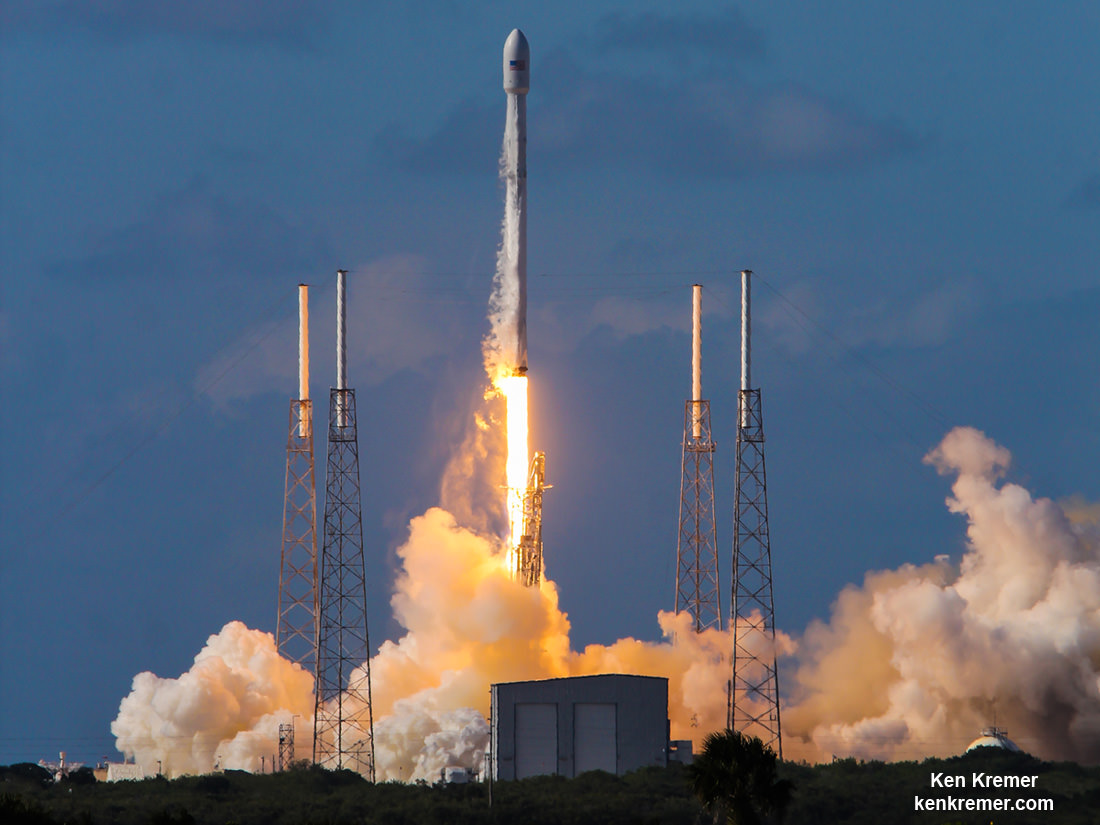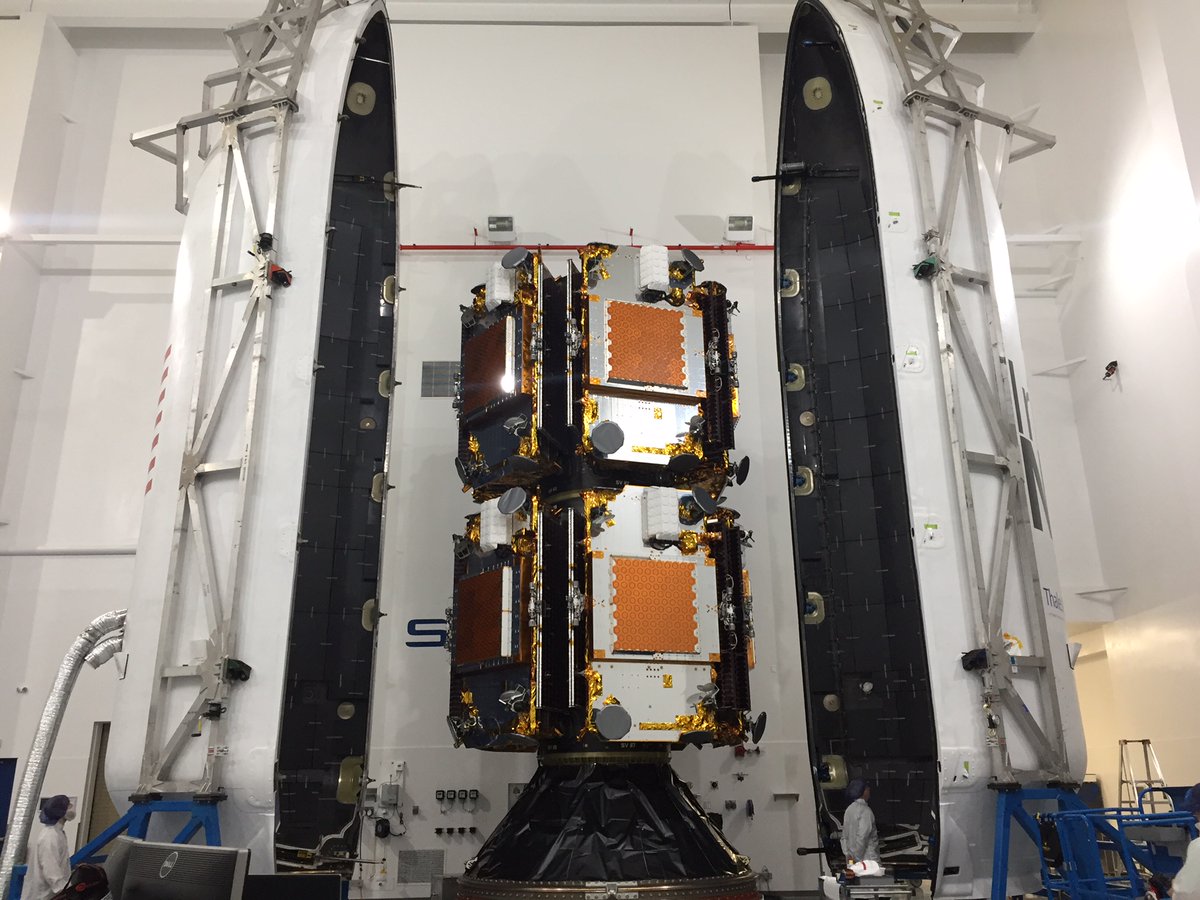
Upgraded SpaceX Falcon 9 blasts off with Thaicom-8 communications satellite on May 27, 2016 from Space Launch Complex 40 at Cape Canaveral Air Force Station, FL. 1st stage booster landed safely at sea minutes later. Credit: Ken Kremer/kenkremer.com
After an intensive four month investigation into why a SpaceX Falcon 9 rocket exploded without warning on the launch pad last September, the company today announced the failures likely cause as well as plans of a rapid resumption of flights as soon as next Sunday, Jan. 8, from their California launch complex - carrying a lucrative commercial payload of 10 advanced mobile relay satellites to orbit for Iridium Communications.
"Targeting return to flight from Vandenberg with the @IridiumComm NEXT launch on January 8," SpaceX announced on their website today, Monday, Jan. 2., 2017.
"Our date is now public. Next Sunday morning, Jan 8 at 10:28:07 pst. Iridium NEXT launch #1 flies!" Iridium Communications CEO Matt Desch quickly confirmed by tweet today, Jan 2.
SpaceX has been dealing with the fallout from the catastrophic launch pad explosion that eviscerated a Falcon 9 and its expensive $200 million Israeli commercial payload in Florida without warning, during a routine preflight fueling test on Sept. 1, 2016, at pad 40 on Cape Canaveral Air Force Station.

The first ten IridiumNEXT satellites are stacked and encapsulated in the Falcon 9 fairing for launch from Vandenberg Air Force Base, Ca., in early 2017. Credit: Iridium
After the Sept. 1 accident at pad 40, SpaceX initiated a joint investigation to determine the root cause with the FAA, NASA, the US Air Force and industry experts who have been "working methodically through an extensive fault tree to investigate all plausible causes."
"We have been working closely with NASA, and the FAA [Federal Aviation Administration] and our commercial customers to understand it," said SpaceX CEO Elon Musk.
Via the "fault tree analysis" the Sept. 1 anomaly has been traced to a failure in one of three helium storage tanks located inside the second stage liquid oxygen (LOX) tank of the Falcon 9 rocket, according to a statement released by SpaceX today which provided some but not many technical details.
The failure apparently originated at a point where the helium tank "buckles" and accumulates oxygen - "leading to ignition" of the highly flammable liquid oxygen propellant in the second stage.
The helium tanks - also known as composite overwrapped pressure vessels (COPVs) - are used in both stages of the Falcon 9 to store cold helium which is used to maintain tank pressure.
"The accident investigation team worked systematically through an extensive fault tree analysis and concluded that one of the three composite overwrapped pressure vessels (COPVs) inside the second stage liquid oxygen (LOX) tank failed."
"Each COPV consists of an aluminum inner liner with a carbon overwrap."
"Specifically, the investigation team concluded the failure was likely due to the accumulation of oxygen between the COPV liner and overwrap in a void or a buckle in the liner, leading to ignition and the subsequent failure of the COPV."
SpaceX says investigators identified "an accumulation of super chilled LOX or SOX in buckles under the overwrap" as "credible causes for the COPV failure."
SpaceX says they will address the causes of the mishap through both short term and long term "corrective actions."
"The corrective actions address all credible causes and focus on changes which avoid the conditions that led to these credible causes."
The short term fixes involve simpler changes to the COPV configuration and modifying the helium loading conditions.
"In the short term, this entails changing the COPV configuration to allow warmer temperature helium to be loaded, as well as returning helium loading operations to a prior flight proven configuration based on operations used in over 700 successful COPV loads."
The long term fixes involve changing the COPV hardware itself and will take lobger to implement. They are also likely to be more effective - but only time will tell.
"In the long term, SpaceX will implement design changes to the COPVs to prevent buckles altogether, which will allow for faster loading operations."
Liftoff of the SpaceX Falcon 9 with the payload of 10 identical next generation IridiumNEXT communications satellites will take place from Space Launch Complex 4E on Vandenberg Air Force Base in California - assuming the required approval is first granted by the Federal Aviation Administration (FAA).
No Falcon 9 launch will occur until the FAA gives the 'GO.'
Furthermore, in anticipation of announcing the targeted 'Return to Flight' launch date, technicians have already processed the Falcon 9 rocket for the 'Return to Flight' blastoff with the vanguard of a fleet of IridiumNEXT mobile voice and data relay satellites for Iridium Communications - as I reported last week in my story here - and subsequently tweeted by Iridium CEO Matt Desch saying "Nice recap."
Last week, the first ten IridiumNEXT mobile voice and data relay satellites were fueled, stacked and tucked inside the nose cone of the Falcon 9 rocket designated as SpaceX's 'Return to Flight' launcher in order to enable a blastoff as soon as possible after an approval is received from the FAA.
"Iridium is pleased with SpaceX's announcement on the results of the September 1 anomaly as identified by their accident investigation team, and their plans to target a return to flight on January 8 with the first Iridium NEXT launch" Iridium Communications said on their website today, Jan. 2.
Stay tuned here for Ken's continuing Earth and Planetary science and human spaceflight news.
Ken Kremer






No comments:
Post a Comment